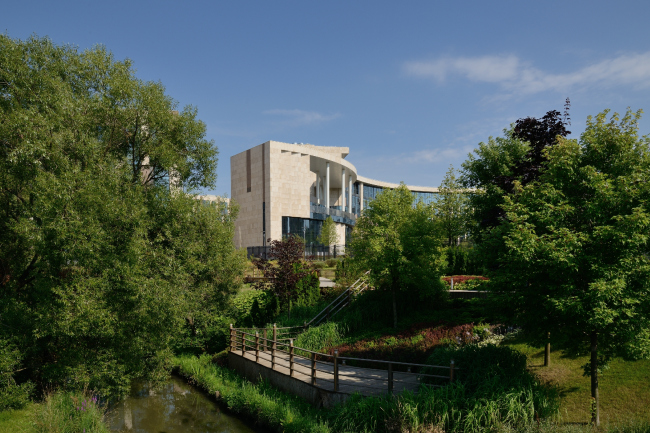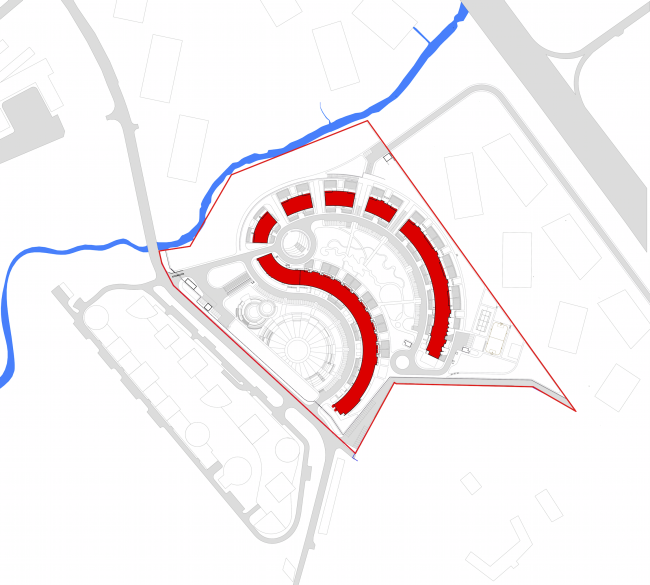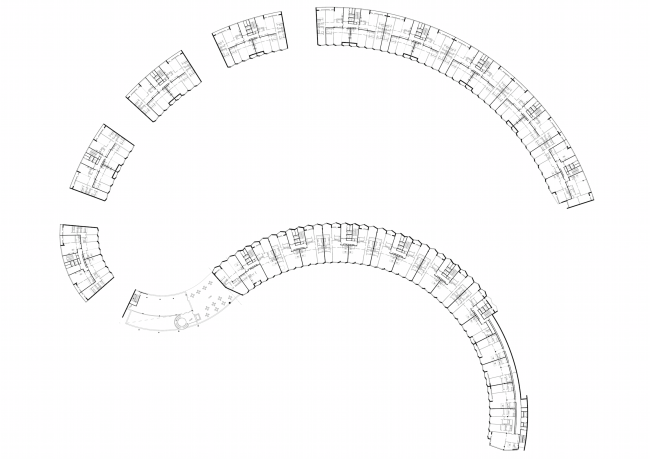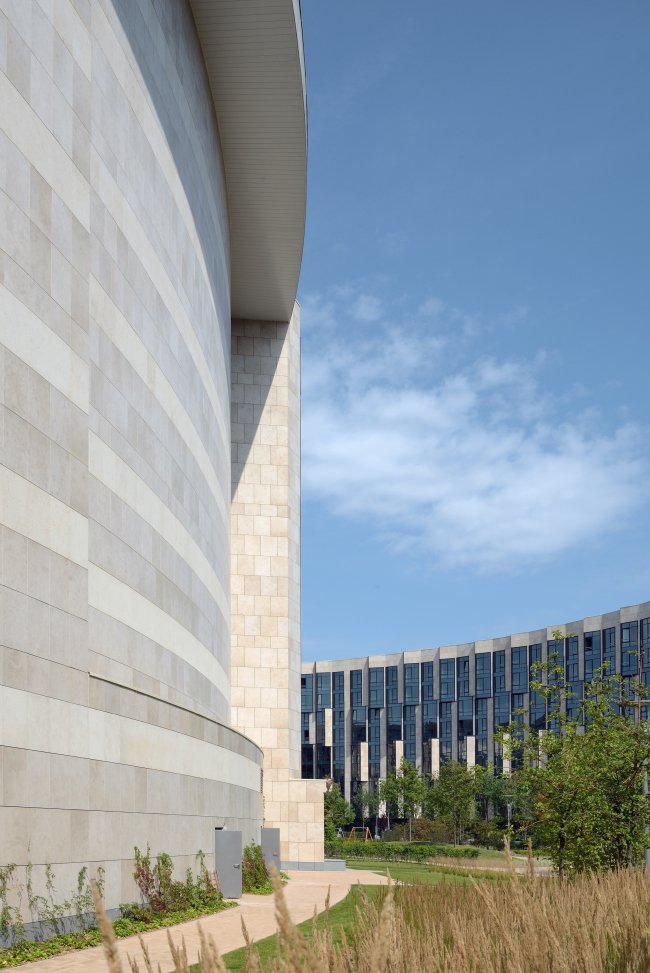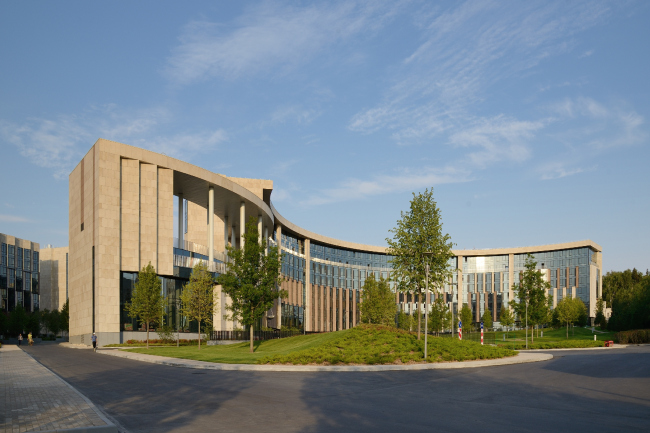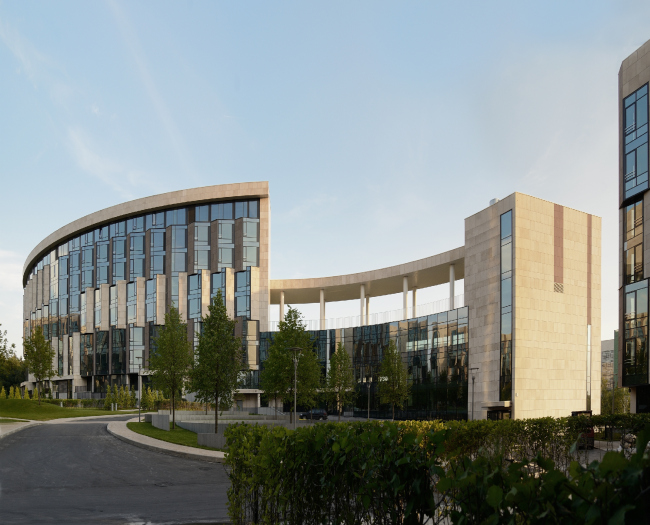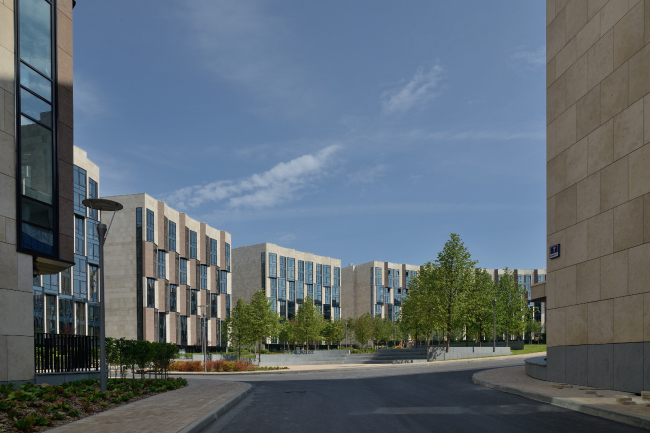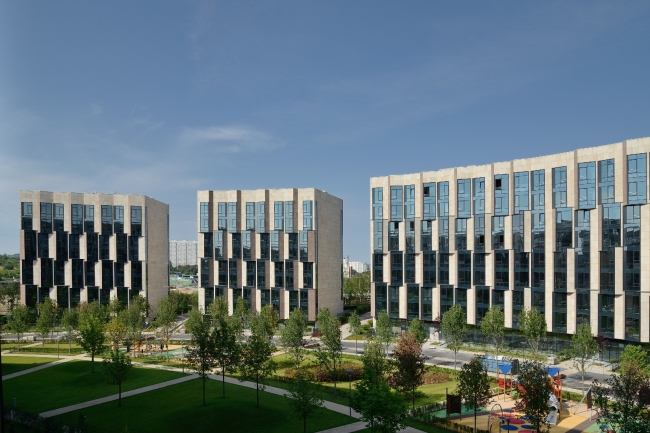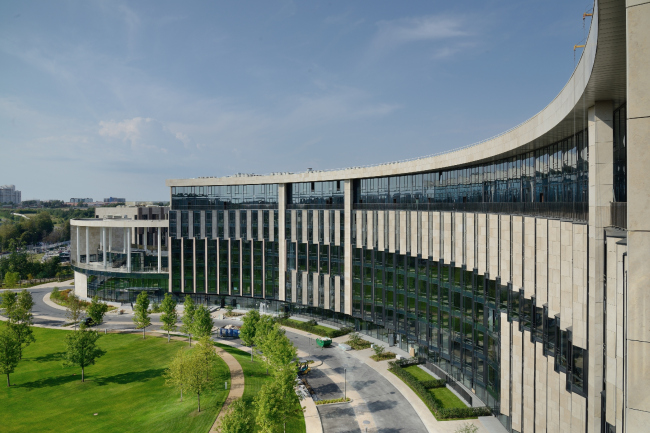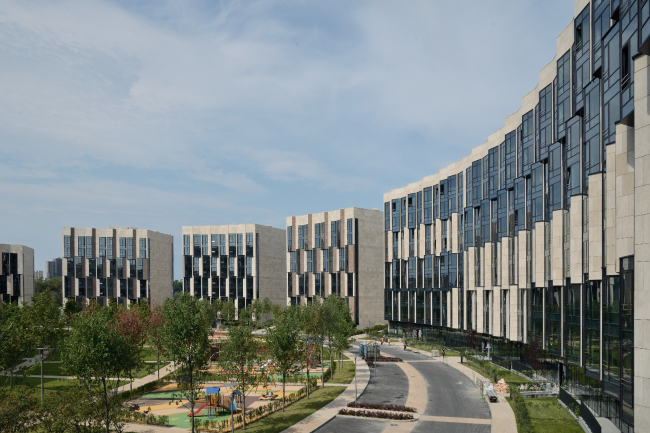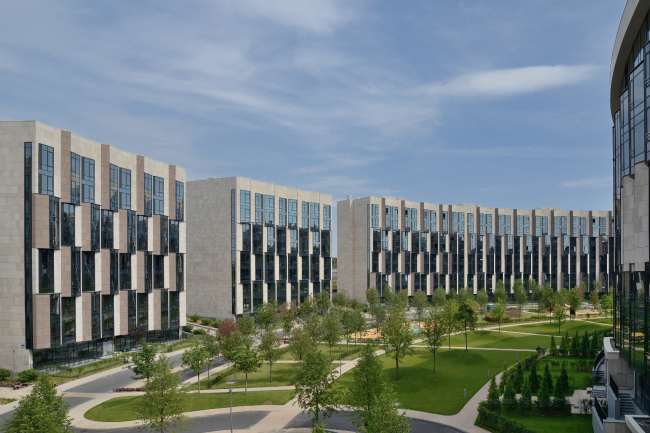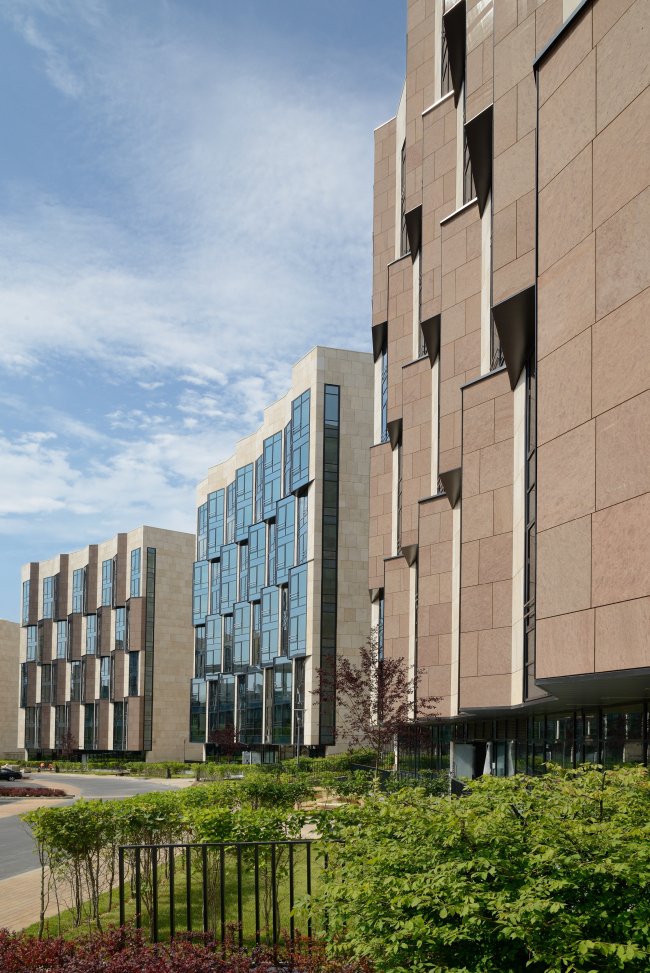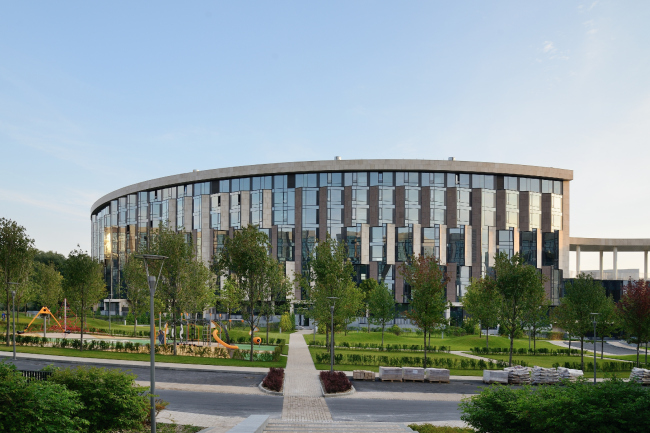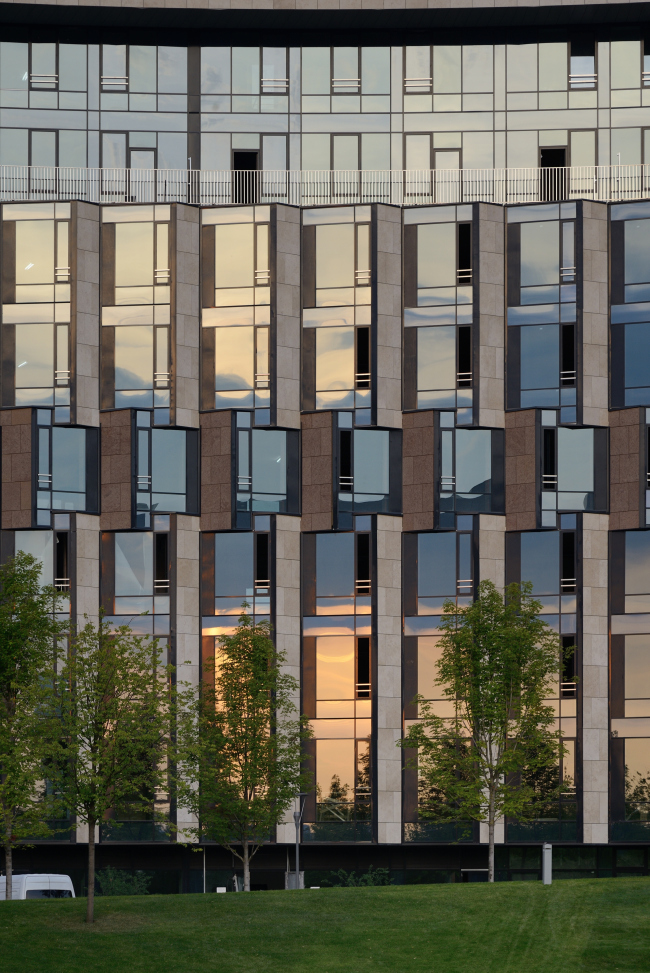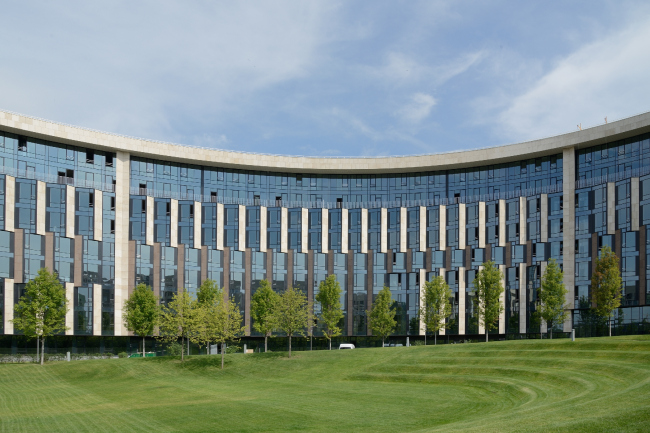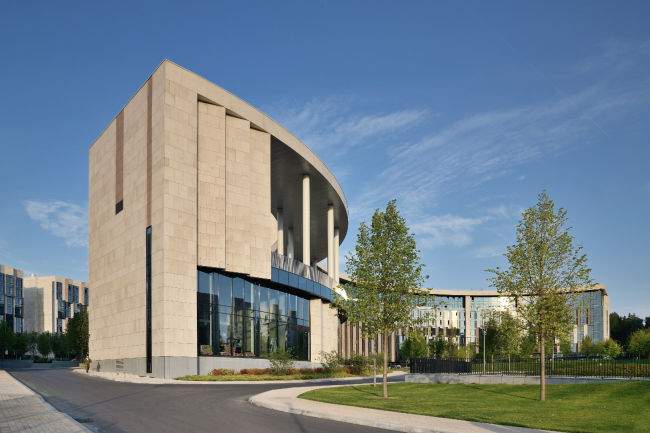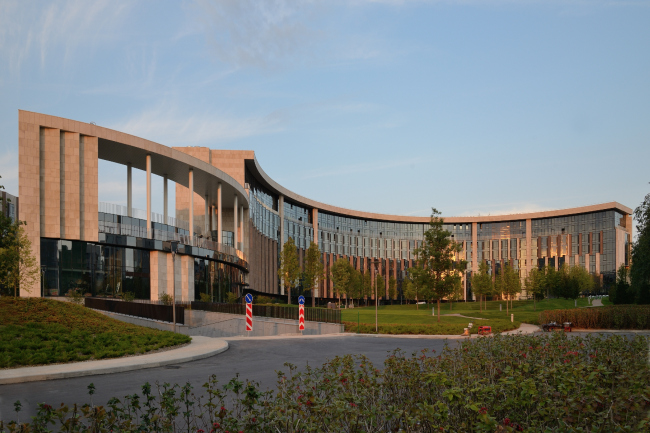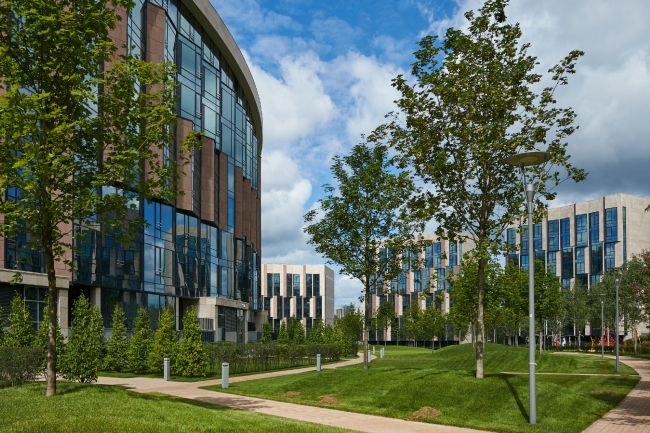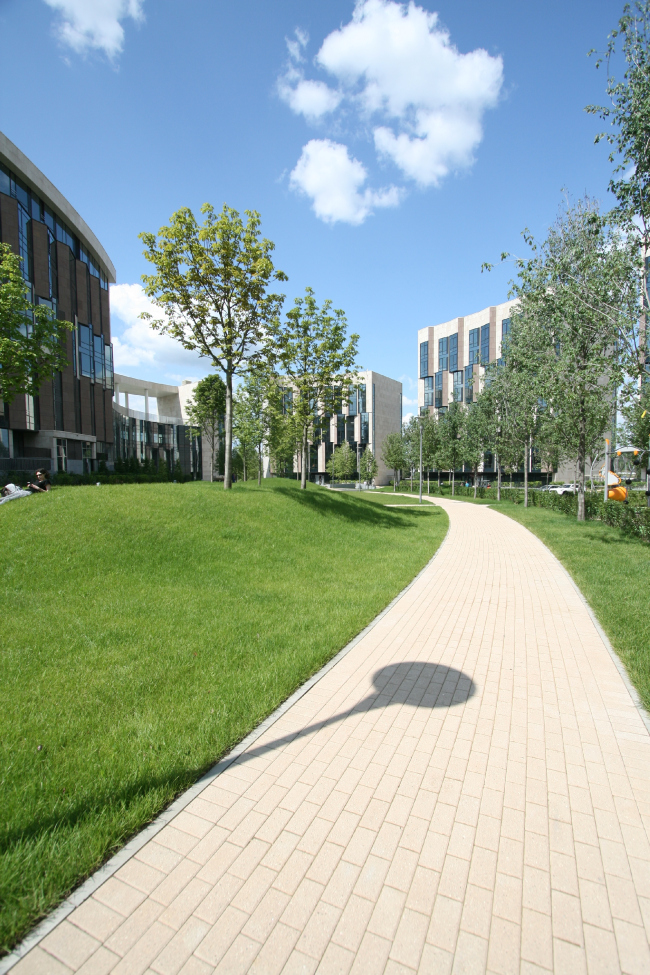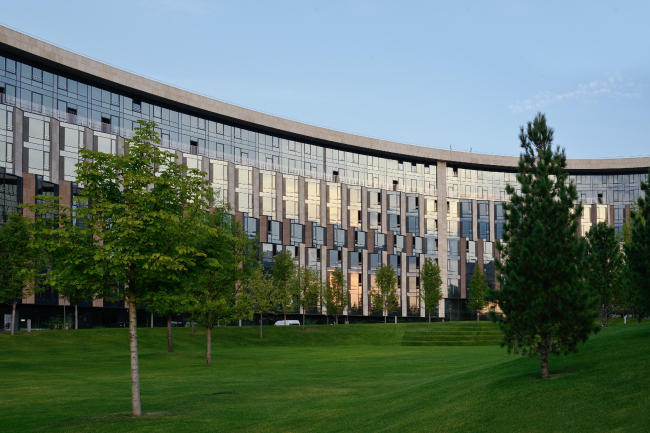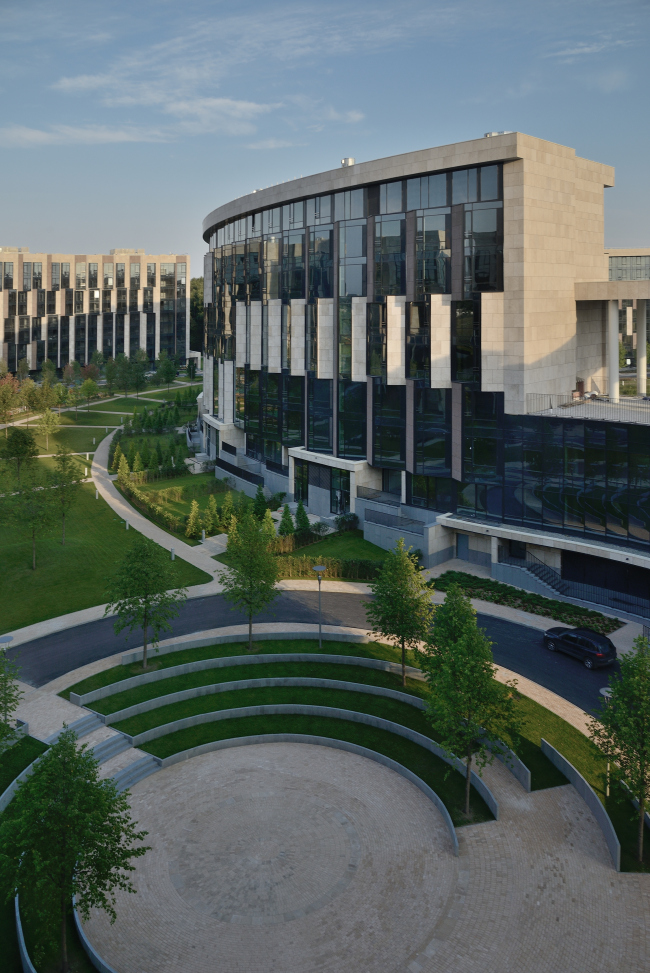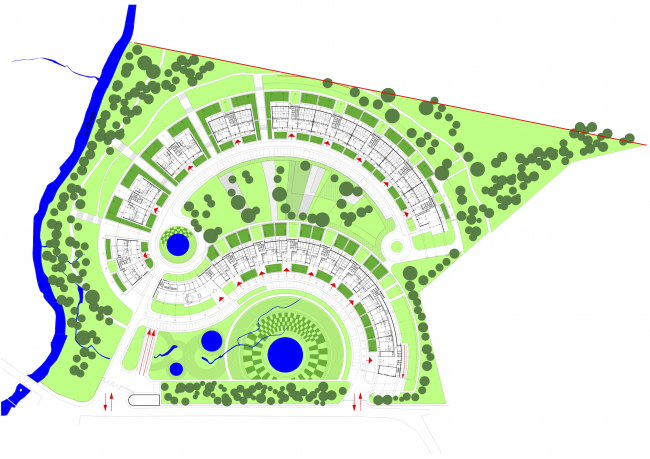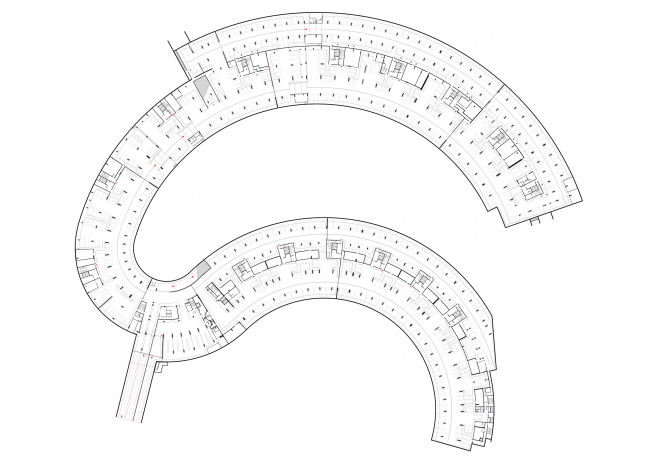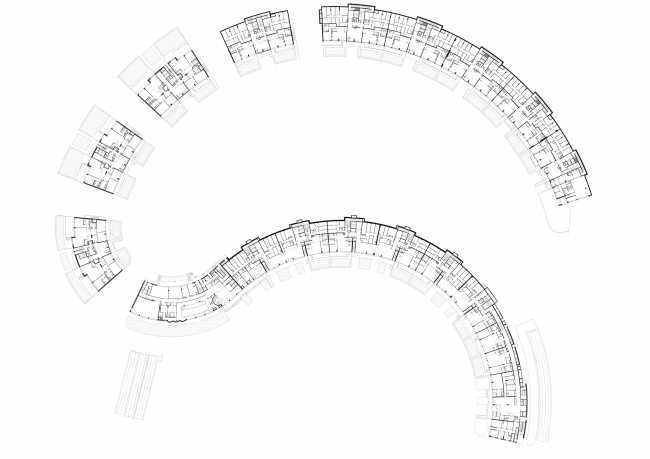|
The almost theatrical scenography, mechanisms of modern architecture and nostalgia for mansions are combined in this house so unobtrusively and subtly that one even breathes more freely around it.
The premium housing estate “Skolkovo Park” was built on the order of Millhouse development company not far from the innovation center “Skolkovo” – currently under construction – on Vesennaya Street in Estate Zarechie. Prime class and large apartments (from 60 to 130 m2), and Millhouse owns about 600 hectares of land here, including Park Meshersky improved by the developer and the largest golf club in Europe.
The arc-shaped form of the buildings in “Skolkovo Park” has – according to the words of architect Vladimir Plotkin – resulted from multiple restrictions. In short, the house had to bend in such a way, as to get the most of the sunlight for the dwellers. The case is that according to the rules of the surrounding territory, not a single window of the housing estate could face the south – the best side in terms of insolation. Eastward is the noisy Moscow Ring Road, and the most appealing part of the landscape – the river – is situated on the northern side. So, as the architect explained in the interview to “Project Russia” magazine (No. 77, 2015, p. 41-56), the arcs in the plan were at first part of a joke: a sum of thoughts about perspectives most convenient for insolation.
Which is why the “legs” of the building face the south with their blind ends, stone rounded wall and a line of “spurs”. This curve also restricts the windows from turning into the wrong direction, but at the same time allows parts of the embrasures to catch the rays of the south-west sun. A large part of the facades is covered with triangular bay windows – “the light traps”.
But the greatest advantage of this house is the lightness of its architecture. Thin lines, almost ephemeral, noble, reminding Modigliani… Nothing is inert; there are no crowded volumes or pressure of weight. This effect can hardly be seen even on very good photos, but you can easily feel it in presence, because it is all about movement and the constantly changing reflections of the sky and the perspectives. The architectural composition is emphatically dramatized – the building leads the spectator using the methods of baroque scenography: it embraces the forestage with the circumference of its inverted façade, plays with the beams of “visual outbreaks” slicing the curve of the north-east part into separate buildings giving a view of the river between them – just as if between the scenes.
Besides, unlike houses with “well” courtyards and the snake-houses of “classical” modernism –in this case it is hard to figure out at once how the facades are organized, to make out the squares of windows. It is all because of the bay windows that connect either two or three floors confusing the perception of the tiers and sizes. In their meeting points they slightly “cling” lending to the façade resemblance with a mechanism: a conveyor or a bicycle chain. Edges and ribs break the curving surface making it lose the inherent sculpturesqueness. Needless to say, that it is one of the favorite author’s solutions of Vladimir Plotkin for rounded volumes. The ribbed cylinder method was first found in one of the projects of 2008 for an office complex on Valovaya Street. And just recently the same ribbed façade and the same combination of light and dark stone appeared in the project for Kul’neva Street.
Another characteristic feature is the peculiar combination of glass and stone. They are almost half and half, and two types of limestone were used: light and dark – the latter accents the shades and compensating the lack of contrasting sun in our climate zone with the special architectural grisaille. The important thing is that grisaille is essentially a graphic, not a dimensional device. The stone goes on being graphical: bars of limestone “float” in the cold surface of glass like leaves upon water and create a single pattern with glass. So the difference between glass and stone goes down to nuances of transparency – and such approach is almost declaratively anticlassical.
However, the familiar tectonic role of stone has not been completely ignored. It forms a large frame from the cornice and several vertical moldings similar to bolsters of a gigantic order but standing wide apart, thin and resembling an open book. However, this conventional “colonnade” arouses multiple associations – from antique to mansion-related. This theme is continued by another smaller colonnade on the roof of the glass community center. Its function will apparently be the restaurant terrace. But figuratively it is an anti-tower that accents the yard entrance and is simultaneously a belle vue garden house, the relative of the rotunda in the mansion parks reminding, for instance, of the Apollo Colonnade at Pavlovsk.
It is as if a mansion palace with a park is transforming into a modern house right in front of us: one thing grows bigger, another smaller – and already the nostalgic fragments are fused into the new structure. It is the way you find antique reliefs in the walls of roman courtyards.
A tinge of nostalgia for the lost peacefulness of the Golden Age is resonated with by the improved territory. The first improvement project was proposed by TPO “Reserve”. Then the client organized a tender, won by an English bureau Hyland Edgar Driver. Vladimir Plotkin highly appreciated the improvement plan that was suggested and implemented by the British company – and in fact, it is a very accurately designed, beautiful and easily comprehendible landscape: comfortable and not overcrowded. The park is planted with flowers that bloom in turn and change the leaves colors regularly refreshing the view of the landscape; the lawns improved with soft geoplastics; everything is lit with soft, not blaring reflected light. The territory of the housing complex is rather big and is not densely developed, giving “air” to the residents. There are small front gardens before the ground floor apartments – personal pieces of ground for the residents.
But the key parts of the park are the two amphitheaters placed by the English architects in the places where manmade ponds were planned according to “Reserve” project. Those are places predetermined by the architecture of the building, and first of all, the circle in the center of the compass that drew the curve of the façade. The English bureau has turned it into a charming green amphitheater: the steps covered with grass remind the theatres of ancient cities, not the restored ones, but the authentic earthquake-ruined, where the stone seats were shifted or gone altogether, and the steps remained. It resonates with the contour colonnade of the façade and awakens the mind of the stroller bringing more sense to an idle walk.
But if we look around and see the big picture we will easily notice that the areas surrounding Skolkovo Highway are currently in the height of transformation. Earlier, just like along the neighboring Rublyovskoe Highway, there were only fences of country residences of influential people – even now, as soon as you turn aside a little, you appear in a gorge of fences. “Skolkovo Park” also has a fence, but it is different – it is transparent, aligned with the ideology of the project – light and natural. The house, as well as its “garden” do not hide inside a palace shell – but unwind upon the wide open space, breathe in the air as if saying in the morning: how wonderful! And what else does a person need?
"Skolkovo-Park". Photo © Aleksey Naroditsky, 2015
"Skolkovo-Park". On the foreground: the embankment of the Setun' River. Photo © Aleksey Naroditsky, 2015
"Skolkovo-Park". Location plan © Creative Union "Reserve"
"Skolkovo-Park". Plan of the typical floor © Creative Union "Reserve"
"Skolkovo-Park". Photo © Aleksey Naroditsky, 2015
"Skolkovo-Park". Photo © Aleksey Naroditsky, 2015
"Skolkovo-Park". Photo © Aleksey Naroditsky, 2015
"Skolkovo-Park". Photo © Aleksey Naroditsky, 2015
"Skolkovo-Park". Photo © Aleksey Naroditsky, 2015
"Skolkovo-Park". Photo © Aleksey Naroditsky, 2015
"Skolkovo-Park". Photo © Aleksey Naroditsky, 2015
"Skolkovo-Park". Photo © Aleksey Naroditsky, 2015
"Skolkovo-Park". Photo © Aleksey Naroditsky, 2015
"Skolkovo-Park". Photo © Aleksey Naroditsky, 2015
"Skolkovo-Park". Photo © Aleksey Naroditsky, 2015
"Skolkovo-Park". Photo © Aleksey Naroditsky, 2015
"Skolkovo-Park". Photo © Aleksey Naroditsky, 2015
"Skolkovo-Park". Photo © Aleksey Naroditsky, 2015
"Skolkovo-Park". The eastern facade is almost flat, the bay windows standing out only in its north part. Photo © Aleksey Naroditsky, 2015
"Skolkovo-Park". Photo © Aleksey Naroditsky, 2015
"Skolkovo-Park". Photo © Aleksey Naroditsky, 2015
"Skolkovo-Park". Photo © Aleksey Naroditsky, 2015
"Skolkovo-Park". Photo © Aleksey Naroditsky, 2015
"Skolkovo-Park". Photo © Aleksey Naroditsky, 2015
"Skolkovo-Park". Photo © Aleksey Naroditsky, 2015
"Skolkovo-Park". Photo © Aleksey Naroditsky, 2015
"Skolkovo-Park". Photo © Aleksey Naroditsky, 2015
"Skolkovo-Park". Photo © Aleksey Naroditsky, 2015
"Skolkovo-Park". Photo © Aleksey Naroditsky, 2015
"Skolkovo-Park". Photo © Aleksey Naroditsky, 2015
"Skolkovo-Park". Photo © Aleksey Naroditsky, 2015
"Skolkovo-Park". Photo © Aleksey Naroditsky, 2015
"Skolkovo-Park". Master Plan © Creative Union "Reserve"
"Skolkovo-Park". Plan of the underground parking garage © Creative Union "Reserve"
"Skolkovo-Park". Plan of the first floor © Creative Union "Reserve"
"Skolkovo-Park". Plan of the second floor © Creative Union "Reserve"
"Skolkovo-Park". Section view © Creative Union "Reserve"
"Skolkovo-Park". Section view © Creative Union "Reserve"
"Skolkovo-Park". Section view © Creative Union "Reserve"
"Skolkovo-Park". Section view, project © Creative Union "Reserve"
|




